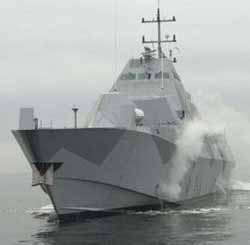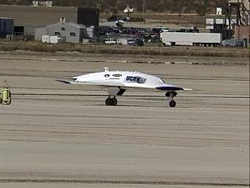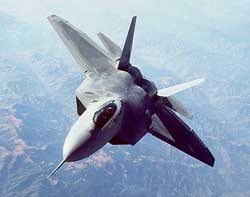Page 1
Daily News
By Gail Helmer
| Send Us News | Archives | Main |
Monday December 10, 2001
PC News
- Matrix Games to Publish Fortress Europe
- New Medal Of Honor Video
- Independence War 2 Free-Form Mod Released
- Independence War 2 Power-Ups Mod Released
- NVIDIA Wins Frontline Award
- Visby Begins Engineering Sea Trials
- UCAV Completes Low Speed Taxi Tests
- AETC Christens First F-22 Maintenance Training Facility
Matrix Games to Publish Fortress Europe
Matrix Games and Lamb Soft Games join forces to publish a new game "Fortress Europe". "Fortress Europe" is an operational-level wargame covering the battle from the landings on June 6, 1944 to the Allied breakout on August 30. Fortress Europe includes a synchronized attack system that allows armor and infantry to attack jointly, with units waiting until all assault forces are in position before launching their attack. Click here for more details.
New Medal Of Honor Video
EA's newest Medal of Honor: Allied Assault video. Town infiltration! Get in, kill the enemy, and get out! Click here
Independence War 2 Free-Form Mod Released
Particle Systems has released a new Independence War 2 mod that lets space pilots continue playing after the game ends, with all their cargo, ships, systems, and trades intact. The mod additionally gives players access to all of the game’s star systems and allows them to trade for advanced weaponry. The mod also is compatible with other current user mods, so players can use other mods to access new ships, weapons, and other content while playing in free-form mode. Download.
Independence War 2 Power-Ups Mod Released
Particle Systems has released a new Independence War 2 that allows you to specify the list of powerups that are available in a multiplayer game on a per-scenario basis. For instance, you could restrict powerups to just beam weapons, or add your own customised powerups. This mod only affects the server behaviour, therefore it is not necessary for clients to have the mod installed or active if they wish to join your game. Download.
NVIDIA Wins Frontline Award
NVIDIA announced today that its GeForce3 3D graphics architecture was honored with Game Developer Magazine's prestigious Front Line award. Each year, Game Developer Magazine singles out select hardware and software companies for providing a breakthrough product that streamlines the game development process and awards them the Front Line award. This year, the winner is the NVIDIA GeForce3 3D graphics architecture. The GeForce 3 graphics architecture introduced NVIDIA Shading Technology to developers as the foundation for DirectX 8. Some of the special effects created with that technology can now be seen on games when they are played back on the GeForce3, GeForce3 Ti 200, GeForce3 Ti 500 and the Xbox.
Military News
Visby Begins Engineering Sea Trials
The Swedish Navy has begun sea trials with its next-generation surface vessel, the Visby corvette. The craft is currently on its maiden voyage during which it will undergo engineering tests under the supervision of Kockums, its manufacturer. The trials are focused on fine-tuning the engines, steering and control systems, prior to embarking on more advanced sea trials.
"The Swedish Navy's next-generation surface vessel, the Visby corvette constitutes a complete stealth concept and is an extremely important contract for Kockums. In collaboration with our German owner, the HDW Group, we are now also engaged in developing an export version," said Hans Hedman, President of Kockums.
The Visby-class corvette, which is the first naval vessel to feature fully developed stealth technology, is built in carbon fibre. This makes her extremely difficult to detect, even when using the most modern and sophisticated radar and IR-sensor systems. The introduction of stealth technology is expected to have a considerable effect in terms of naval tactics. The company has five vessels on order with an option on a sixth vessel.
UCAV Completes Low Speed Taxi Tests
Boeing's Unmanned Combat Air Vehicle (UCAV), the X-45A aircraft is undergoing taxi testing in preparation for its first flight during the first half of next year. The craft completed its initial low speed taxi testing on November 2, which confirmed the autonomous operation of the vehicle and its responsiveness to controller commands. Additional taxi testing will occur during the next few months to verify that all functions are operational before first flight.
The UCAV demonstration programme is being conducted under a $191 million, 56-month cost-share agreement awarded to Boeing in March 1999 by Defense Advanced Research Projects Agency (DARPA) and the Air Force. Boeing's share is $21 million. If this demonstration programme is successful, the DoD could begin employing UCAV weapon systems as early as 2008.
Boeing has produced two X-45A air vehicles, a mission control station and supportability elements for this phase of the programme, the objective of which is to demonstrate that the two vehicles can actually perform a co-ordinated suppression of enemy air defences mission. The X-45A demonstrator system consists of an air vehicle, mission control system and a storage container. The air vehicle, which has no tail, consists of a 27-foot long airframe with a 34-foot wingspan. It weighs 8,000 pounds (empty) and can carry a variety of precision strike munitions.
UCAVs will be equipped with pre-programmed objectives and preliminary targeting information by ground-based mission planners. In this way missions can be carried out autonomously or managed interactively by UCAV battle managers, who will be able to control as many as four vehicles at once, should new objectives or targeting information dictate. Due to their size, lack of pilot interfaces and training requirements, reusability and long-term storage capability, UCAVs are projected to cost up to 65 percent less to produce than future manned fighter aircraft and up to 75 percent less to operate and maintain than current systems.
The programme has recently been recognised by Popular Science magazine's 14th annual Best of What's New issue (December 2001) as one of the world's most interesting and noteworthy breakthrough products and technologies. UCAV received the grand prize in the aviation and space category for representing a significant step forward in the field of aviation and for saving human lives by keeping pilots out of harm's way.
"The unique partnership among DARPA, the Air Force and Boeing on this programme is helping to push back the frontiers of unmanned systems and provide more effective and affordable tools for the warfighter," said Col. Michael Leahy, USAF, DARPA/Air Force UCAV programme manager. "I'm happy to hear that Popular Science recognises the importance of this programme to the future of our country."
AETC Christens First F-22 Maintenance Training Facility
In the next few years, the F-22 Raptor will ascend from a flight test vehicle to a fully functional combat aircraft. The base here moved a step further toward accomplishing this goal Nov. 29 when Detachment 13 of the Air Education and Training Command's 372nd Training Squadron christened the Air Force's first F-22 maintenance training facility.
"The days of overhead projectors and hard copy technical orders are over," said Capt. Rich Flamand, detachment commander. "These new facilities give us 21st century training capabilities for a 21st century aircraft."
The $800,000 facility expansion covers about 5,000 square feet and includes five fully automated classrooms, a hands-on training lab and an F-119 engine bay. The detachment will use the facilities to provide F-22 maintenance training to people in nine different Air Force specialties. An additional expansion, which will house a full-size F-22 forward fuselage seat and canopy trainer, is scheduled for completion in the spring.
The Air Force's initial cadre of F-22 pilots and maintainers will receive their training here and in the skies over Southern Nevada. Detachment 13's facilities will play a major role in this effort.
"The initial pipeline for F-22 maintenance training will be conducted in our facilities," Flamand said. "Our instructors will use the facilities first. They are currently spending time here and at Edwards Air Force Base (Calif.) to get trained and certified to teach the F-22 curriculum. Once we begin our F-22 training here, all maintainers associated with the F-22 programme will be able to be certified here at Nellis."
Five fully automated classrooms with eight computer stations in each provide an electronic interface between instructors, students, and course materials.
"Everything in the classrooms is electronic and interactive, which keeps the attention of our younger maintenance personnel who were raised in a computerised environment," Flamand said. "Instructors can control anything from lighting to room temperature and video settings at each computer station from a touch screen. Students will complete their course work on the same computers where their technical data is stored."
After classroom instruction, some of the facility expansions will allow students to enhance their learning through practical application.
"We will be using actual F-22 parts to provide our students with hands-on training," Flamand said. "Students who use our hands-on training lab will work on an actual F-22 ejection seat and practice fibre optics repair under the same conditions they will encounter in the field.
"Propulsion training will take place with a Pratt and Whitney F-119 engine in our engine bay, and when construction of the seat and canopy addition is complete, students will be able to receive hands-on training in these areas as well," he said.
The detachment is scheduled to begin using the F-22 expansion for maintenance training in as August.
| Send Us News | Archives | Main |


